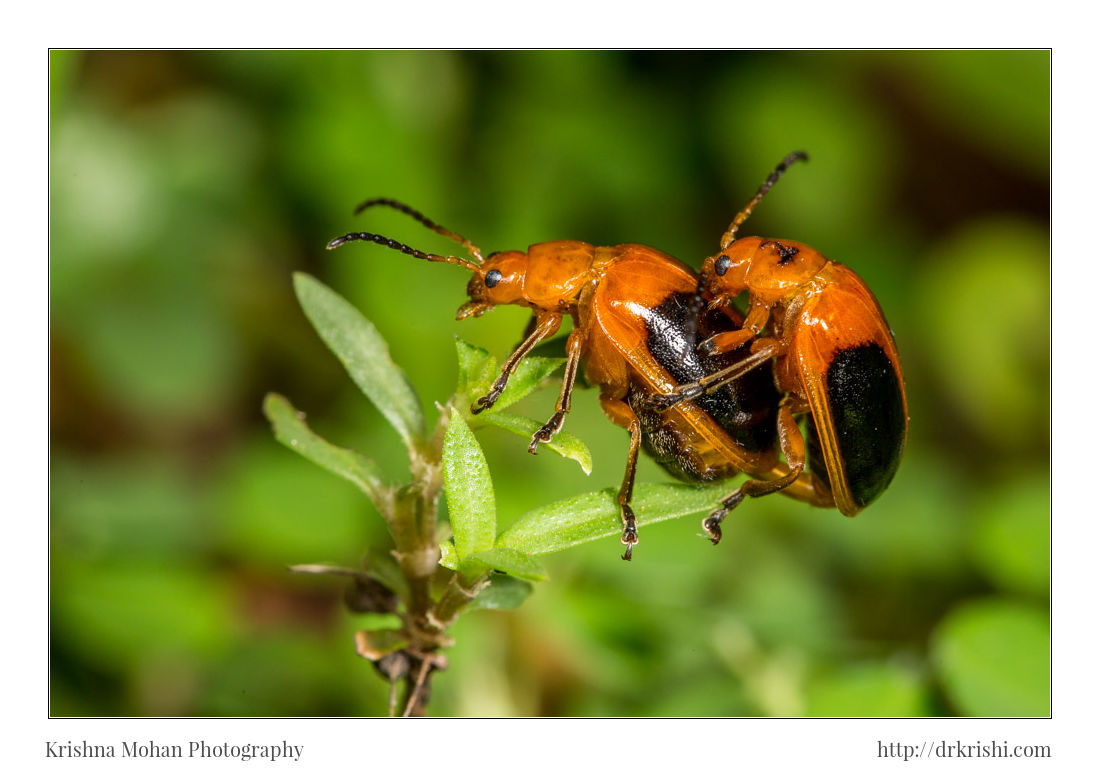
Fierce competition for fertilisation rights is fairly common among insects and has led to the evolution of some truly gruesome sexual strategies. This “sexually antagonistic co-evolution” is found in many species of insects. What you see here is, mating act of Oides species of Flea beetles. Flea beetle is a general name applied to these small, jumping beetles of the leaf beetle family (Chrysomelidae).

I was able to capture the mating very close to the ground level using Canon EOS 5D Mark III and Canon EF 100mm f/2.8L Macro IS USM fitted with Canon MT-24EX macro twin light flash. This was a period when I was experimenting with various modifiers to use effectively with Canon MT-24EX flash. This capture was without any modifier which led to a bad highlight which you can see on the back of these beetles. If you notice my previous blog, where I diffused the Canon MT-24EX flash with a half cut plastic cup, thereby allowing the light to spread evenly, gave a significantly better highlight control.

Female beetle here, has to contend with her partner’s nightmarish penis – an organ covered in hard, sharp spikes. The males’ sexual organs have barbs and spikes that resemble medieval torture instruments. It’s no surprise then that females sustain heavy injuries during sex.
(View pictures of these bizarre beetle genitalia from National Geographic News)
But why have male beetles evolved such hellish genitals? What benefits do they gain by physically harming their partners? It’s possible that the injuries directly benefit the males, either because they stop the females from mating again or spend more efforts in raising their fertilised eggs to avoid the strain of future liaisons.

The alternative is that the spikes could give the males an edge in “sperm competitions“, where they compete with rivals not through direct combat, but through fertilising as many eggs as possible. In this theory, the spines are important for winning these competitions, and the wounds they inflict are simply a nasty side-effect.
It’s not entirely clear what exactly the spines do. They could anchor the male during sex, position his penis in the right spot during sex, or scrape out the sperm of rivals from the female’s genitals. Either way, they have clearly evolved to allow the male seed beetle to out-ejaculate his rivals.

Some species, like the dung fly, also have armoured genitals. Others, like the familiar fly Drosophila melanogaster, have toxic semen laden with chemicals that actually slash the lifespans of females, who can literally mate their way to death. But even here, the effect of this lethal cocktail isn’t the early death of the female; that’s an unfortunate side-effect. Their goal is to encourage the female to lay more eggs or reject further suitors, or even kill the sperm of other males.
And possibly the most horrific sexual technique of all belongs to the male bed bug, whose penis is like a hypodermic needle. He stabs it through the female’s back and injects his semen straight into her abdominal cavity. It’s a method that’s been appropriately named “traumatic insemination”.

For those who think I am only partial towards males here, female insects too have evolved their own defences. The female beetle, for example, has a huge amount of connective tissue lining her sexual tracts so that the damage inflicted by the males doesn’t affect her too badly. She also takes a more direct approach to protecting herself – when she’s had enough, she simply kicks the male until he lets go. Doing so cuts the total length of mating by a third – this is one species where the females want the males to ejaculate sooner.
Reference: http://www.sciencedirect.com/science/article/pii/S0960982212011931


The closing line is epic . ha ha
ವಿಕೃತಕಾಮ ಶಬ್ದಕ್ಕೆ ಈ ಲೋಕದಲ್ಲಿ ಅರ್ಥವೇ ಇಲ್ಲ. Everything is right in love & war ಕೂಡಾ ಬದಲಾಗಬೇಕು when love is war, ಅಬ್ಬ!